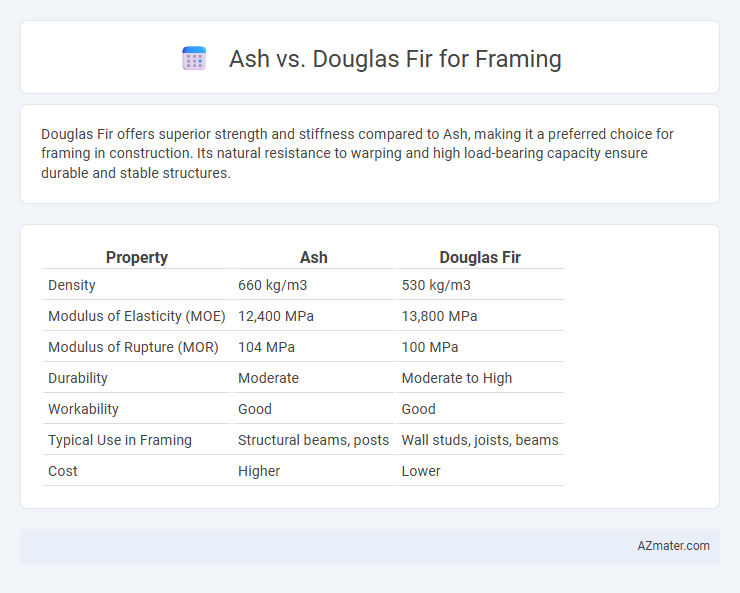Douglas Fir offers superior strength and stiffness compared to Ash, making it a preferred choice for framing in construction. Its natural resistance to warping and high load-bearing capacity ensure durable and stable structures.
Table of Comparison
| Property | Ash | Douglas Fir |
|---|---|---|
| Density | 660 kg/m3 | 530 kg/m3 |
| Modulus of Elasticity (MOE) | 12,400 MPa | 13,800 MPa |
| Modulus of Rupture (MOR) | 104 MPa | 100 MPa |
| Durability | Moderate | Moderate to High |
| Workability | Good | Good |
| Typical Use in Framing | Structural beams, posts | Wall studs, joists, beams |
| Cost | Higher | Lower |
Introduction to Ash and Douglas Fir as Framing Lumber
Ash and Douglas Fir are popular choices for framing lumber due to their strength and durability. Ash offers excellent shock resistance and a straight grain, making it ideal for structural support, while Douglas Fir is prized for its high strength-to-weight ratio and dimensional stability. Both species provide reliable performance in construction, with Douglas Fir often favored for its availability and cost-effectiveness in framing applications.
Wood Strength and Structural Performance
Ash exhibits superior impact resistance and flexibility, making it highly suitable for framing applications requiring durability under dynamic loads. Douglas Fir offers excellent compressive strength and stiffness, providing robust structural support in load-bearing frames. Both woods present strong mechanical properties, but Douglas Fir's higher modulus of elasticity ensures better resistance to bending and deflection in large-scale construction.
Workability and Ease of Use
Ash offers superior workability due to its straight grain and uniform texture, making it easier to cut, shape, and nail during framing projects. Douglas Fir, while strong and widely used in construction, can be harder and more resinous, which may cause increased tool wear and require more effort to achieve precise cuts. Ash's ease of sanding and finishing further enhances its suitability for detailed framing work compared to Douglas Fir.
Sustainability and Sourcing
Ash wood for framing is less common but offers moderate sustainability due to its fast growth and availability in managed forests, making it a renewable choice. Douglas Fir is widely favored in framing for its strength, durability, and sustainable sourcing from well-managed North American forests certified by organizations like FSC and SFI. Choosing Douglas Fir ensures a balance of structural reliability and responsible forestry practices, supporting environmentally conscious construction.
Resistance to Decay and Insects
Douglas Fir exhibits superior resistance to decay and insect damage compared to Ash, making it a preferred choice for framing in environments prone to moisture and pest exposure. Its dense grain structure and natural resin content contribute to enhanced durability and longevity in structural applications. Ash, while strong and flexible, typically requires additional treatment to improve its resistance against decay and insect infestation for framing purposes.
Cost Comparison and Availability
Ash wood generally commands a higher price than Douglas Fir due to its harder grain and appealing grain pattern, making it costlier for framing projects. Douglas Fir is widely available across North America and offers a more budget-friendly option without compromising structural integrity in framing. The abundant supply and lower cost of Douglas Fir make it the preferred choice for large-scale construction and cost-sensitive framing applications.
Environmental Impact and Certifications
Douglas Fir is often favored in framing due to its higher strength-to-weight ratio and availability from sustainably managed forests certified by the Forest Stewardship Council (FSC), ensuring lower environmental impact and responsible harvesting. Ash, while durable and aesthetically pleasing, is less commonly sourced from certified sustainable forests, which can result in greater ecological concerns during large-scale framing projects. Choosing FSC-certified Douglas Fir supports biodiversity conservation and carbon sequestration, contributing to greener building practices.
Finishing and Aesthetic Qualities
Ash wood offers a warm, golden hue with a pronounced grain pattern that enhances visual appeal in framing projects, especially after sanding and clear finishing. Douglas Fir displays a straighter, more uniform grain with a light reddish-brown tone that stains well but tends to absorb finishes unevenly, requiring careful application for optimal aesthetics. Both woods provide good durability, but Ash's smoother texture allows for a more refined finish, making it preferred for visible framing elements where appearance is critical.
Common Applications in Construction
Ash and Douglas Fir are both prominent choices for framing in construction due to their strength and durability. Douglas Fir is favored for structural framing, including wall studs, floor joists, and roof trusses, because of its high strength-to-weight ratio and resistance to warping. Ash, while less common, is used in specialized framing applications where toughness and impact resistance are needed, often in custom or decorative framing elements.
Choosing the Right Wood for Your Framing Project
Ash offers excellent shock resistance and is moderately strong, making it suitable for framing projects requiring durability and flexibility. Douglas Fir stands out for its superior strength-to-weight ratio, consistent grain, and resistance to warping, making it a preferred choice for structural framing in residential and commercial construction. Selecting the right wood depends on project requirements: choose Douglas Fir for high load-bearing needs and consistent performance, while Ash suits applications needing moderate strength with enhanced flexibility.

Infographic: Ash vs Douglas Fir for Framing
 azmater.com
azmater.com